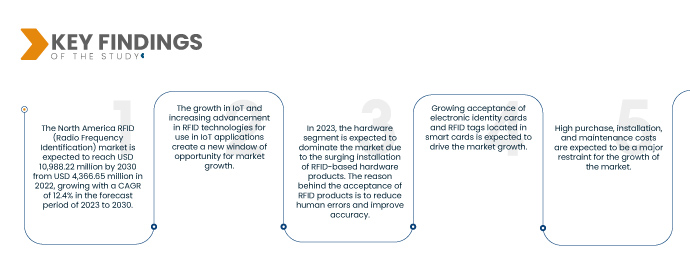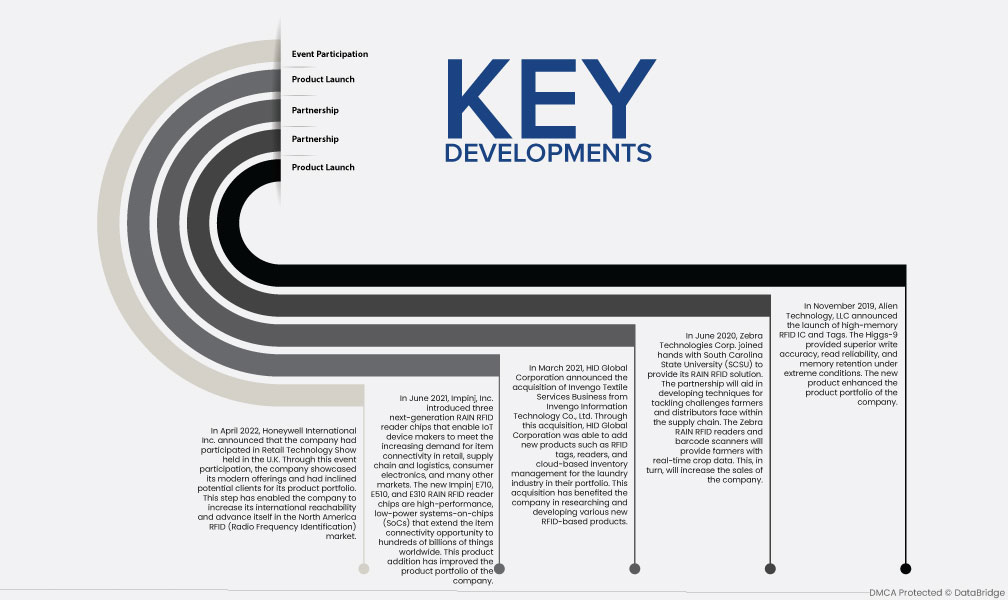In February 2018, GAO Group organization released a report regarding RFID. In this report, they have mentioned that RFID is giving a heavy advantage in the manufacturing industry. They have stated that RFID is helpful in production, supply chain, and inventory management. They have added that RFID tags help store a lot of information utilized to optimize production processes. In assembly line productions, like automotive manufacturing, RFID can aid in making the manufacturing process more flexible. The U.S. Department of Energy also released a detailed report regarding RFID and its uses. In this report, they have mentioned some of the uses of RFID in warehouses. A total of 99 items can be tagged with RFID tags
Access Full Report at @ https://www.databridgemarketresearch.com/jp/reports/north-america-rfid-market
Data Bridge Market Research analyses that North America RFID (Radio Frequency Identification) Market is expected to reach USD 10,988.22 million by 2030 from USD 4,366.65 million in 2022, growing with a CAGR of 12.4% in the forecast period of 2023 to 2030.
Key Findings of the Study
- The North America RFID (Radio Frequency Identification) market is expected to reach USD 10,988.22 million by 2030 from USD 4,366.65 million in 2022, growing with a CAGR of 12.4% in the forecast period of 2023 to 2030.
- The growth in IoT and increasing advancement in RFID technologies for use in IoT applications create a new window of opportunity for market growth.
- In 2023, the hardware segment is expected to dominate the market due to the surging installation of RFID-based hardware products. The reason behind the acceptance of RFID products is to reduce human errors and improve accuracy.
- Growing acceptance of electronic identity cards and RFID tags located in smart cards is expected to drive the market growth
- High purchase, installation, and maintenance costs are expected to be a major restraint for the growth of the market
Increasing the installation of RFID systems in the manufacturing industry to improve productivity
Manufacturers are always looking for advanced ways to optimize operations and reduce expenses. Radio-frequency identification (RFID) technology can optimize the supply chain by improving material flow and tracking damages. Increased automation, paired with the widespread availability of smart gadgets and associated wireless networks such as RFID, allows for unprecedented levels of flexibility and efficiency. RFID technology is widely employed in manufacturing since it provides numerous benefits, such as better product monitoring, more accurate WIP status, fewer manufacturing errors, and a higher-quality product. RFID enables real-time sight of material and assets, which is essential for running the production process smoothly.
Report Scope and Market Segmentation
|
Report Metric
|
Details
|
|
Forecast Period
|
2023 to 2030
|
|
Base Year
|
2022
|
|
Historic Years
|
2021 (Customizable to 2020 - 2017)
|
|
Quantitative Units
|
Revenue in USD Million, Volumes in Units, Pricing in USD
|
|
Segments Covered
|
Offering (Hardware, Software, and Services), Connectivity (Bluetooth, Ultra wide Band, and Others), Material Type (Plastic, Metal, Paper, Glass, and Others), End User (Retail/Commercial, Industrial, Healthcare, Consumer Package Goods, Automotive, Aerospace, Surveillance and Security, Logistics and Transportation, Sports, Defense, Education, Livestock & Wildlife, and Others)
|
|
Country Covered
|
U.S., Canada, and Mexico
|
|
Market Players Covered
|
CCL Industries, Honeywell International Inc., HL, Smart Label Solutions, Omnia Technologies, SES RFID GmbH, Invengo Technology Pte. Ltd., RFID4U, AVERY DENNISON CORPORATION, Jadak – A Novanta Company, Alien Technology, LLC, CoreRFID, Impinj, Inc., Nedap N.V., NXP Semiconductors, Zebra Technologies Corp., Pepperl+Fuchs SE, SimplyRFID, Identiv, Inc., HID Global Corporation, part of ASSA ABLOY among others
|
|
Data Points Covered in the Report
|
In addition to the insights on market scenarios such as market value, growth rate, segmentation, geographical coverage, and major players, the market reports curated by the Data Bridge Market Research also include depth expert analysis, patient epidemiology, pipeline analysis, pricing analysis, and regulatory framework.
|
Segment Analysis:
The North America RFID (Radio Frequency Identification) market on the basis of offering, connectivity, material type, and end user.
- On the basis of offering, the North America RFID (Radio Frequency Identification) market is segmented into hardware, software, and services. In 2023, the hardware segment is expected to dominate the North America RFID (Radio Frequency Identification) market with a 53.07% market share.
In 2023, the hardware segment is expected to dominate the market due to the surging installation of RFID-based hardware products. The reason behind the acceptance of RFID products is to reduce human errors and improve accuracy.
- On the basis of connectivity, the North America RFID (Radio Frequency Identification) market has been segmented into Bluetooth, ultra-wideband, and others. In 2023, the Bluetooth segment is expected to dominate the North America RFID (Radio Frequency Identification) market with a 53.36% market share.
In 2023, the Bluetooth segment is expected to dominate the market due to its cost-efficiency, fast connectivity, and data encapsulation, facilitating its market growth
- On the basis of material type, the North America RFID (Radio Frequency Identification) market has been segmented into plastic, metal, paper, glass, and others. In 2023, the plastic segment is expected to dominate the North America RFID (Radio Frequency Identification) market with a 32.38% market share.
- On the basis of end user, the North America RFID (Radio Frequency Identification) market has been segmented into retail/commercial, industrial, healthcare, automotive, aerospace, surveillance and security, logistics and transportation, sports, defense, education, livestock & wildlife, and others. In 2023, the retail/commercial segment is expected to dominate the North America RFID (Radio Frequency Identification) market with a 17.90% market share.
Major Players
Data Bridge Market Research recognizes the following companies as the major market players such as Zebra Technologies Crop. (U.S.), AVERY DENNISON CORPORATION (U.S.), Honeywell International Inc. (U.S.), CCL Industries, Impinj, Inc., and among others.
Market Development
- In April 2022, Honeywell International Inc. announced that the company had participated in Retail Technology Show held in the U.K. Through this event participation, the company has showcased its modern offerings and had inclined potential clients for its product portfolio. This step has enabled the company to increase its international reachability and advance itself in the North America radio frequency identification technology market
- In April 2022, Honeywell International Inc. announced that the company had participated in Retail Technology Show held in the U.K. Through this event participation, the company showcased its modern offerings and had inclined potential clients for its product portfolio. This step has enabled the company to increase its international reachability and advance itself in the North America radio frequency identification technology market
- In March 2021, HID Global Corporation announced the acquisition of Invengo Textile Services Business from Invengo Information Technology Co., Ltd. Through this acquisition, HID Global Corporation was able to add new products such as RFID tags, readers, and cloud-based inventory management for the laundry industry in their portfolio. This acquisition has benefited the company in researching and developing various new RFID-based products
- In June 2020, Zebra Technologies Corp. joined hands with South Carolina State University (SCSU) to provide its RAIN RFID solution. The partnership will aid in developing techniques for tackling challenges farmers and distributors face within the supply chain. The Zebra RAIN RFID readers and barcode scanners will provide farmers with real-time crop data. This, in turn, will increase the sales of the company
- In November 2019, Alien Technology, LLC announced the launch of high-memory RFID IC and Tags. The Higgs-9 provided superior write accuracy, read reliability, and memory retention under extreme conditions. The new product enhanced the product portfolio of the company
COVID-19 Impact Analysis
COVID-19 negatively impacted the North America RFID (radio frequency identification) market due to the shutdown of global logistics and transportation and the lack of testing for the system.
The COVID-19 pandemic has impacted the North America RFID (radio frequency identification) market to an extent in a negative manner. However, the word RAIN is derived from Radio frequency Identification that acts as a nod to act as a link between UHF metal RFID and the cloud. The cloud helps store and manage the data that can be further shared through the internet. RAIN RFID is, therefore, a wireless technology that helps connect billions of everyday items to the internet, allowing several consumers to further identify, locate, authenticate, and engage each item. With increasing automation in various industries and increasing use of connected equipment, manufacturers are developing RAIN RFID tags to gain a larger market share, increasing the market's growth.
The market players are conducting multiple research and development activities to improve the technology involved in the accessories. With this, the companies will bring advancement and innovation to the market. In addition, government funding for RFID has led the market growth.
Regional Analysis
Geographically, the countries covered in the North America RFID (Radio Frequency Identification) market report are U.S., Canada, and Mexico.
As per Data Bridge Market Research analysis:
The U.S. is the dominant country in the North America RFID (Radio Frequency Identification) market during 2023 - 2030.
The U.S. is expected to dominate the market as the country has an increasing adoption of RFID tags for industry 4.0, IOT, and smart manufacturing compared to other regions. The demand for RFID solutions has been growing rapidly in various end-use industries, such as retail, healthcare, logistics and transportation, and government and defense. The retail sector, in particular, has been one of the largest adopters of RFID technology, driven by the need for efficient inventory management and loss prevention are key factors driving the market. In addition, the U.S. is expected to dominate the market as a well-established infrastructure, a large number of RFID solution providers, and a high level of technological sophistication, which contribute to its dominant position in the market.
For more detailed information about this market report, click here – https://www.databridgemarketresearch.com/jp/reports/north-america-rfid-market














